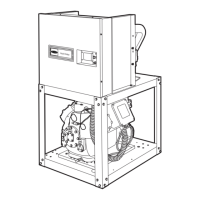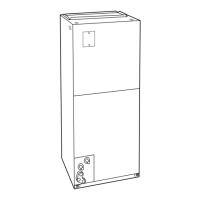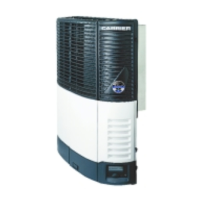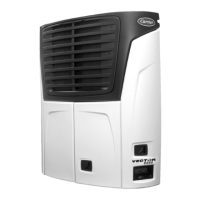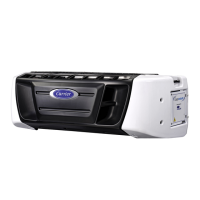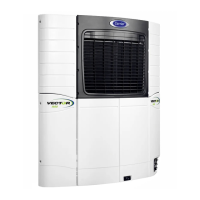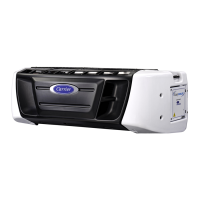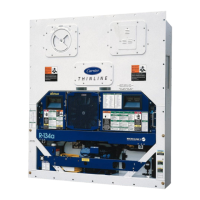24
Run wiring to the space sensor as shown in Fig. 22.
Note that when the remote sensor is used, the red jumper
wires provided must be connected from TB4 terminal 4 to 5
and TB4 terminal 5 to 1.
Both the T55 and T56 have a CCN communications port and
this should be wired to the CCN Communications TB3 board if
it is desired to have access to the CCN system through the sen-
sor. If more than one T55 sensor is being used and averaged,
sensors must be wired in multiples of 4 or 9 as shown in Fig. 23.
T58 Communicating Thermostat
— Carrier also has a fully
communicating thermostat which, if used, will be wired to the
CCN communication connections on TB3 as described in the
Carrier Comfort Network
®
Interface section below.
Carrier Comfort Network (CCN) Interface
— The rooftop
units can be connected to the CCN system. The communica-
tion bus wiring is supplied and installed in the field. Wiring
consists of shielded, 3-conductor cable with drain wire. The
system elements are connected to the communication bus in a
daisy chain arrangement. The positive pin of each system ele-
ment communication connector must be wired to the positive
pins of the system element on either side of it, the negative pins
must be wired to the negative pins, and the signal pins must be
wired to signal ground pins. Wiring connections for CCN sys-
tem should be made at the TB3 terminal block using the screw
terminals. The TB3 board also contains an RJ14 CCN plug that
can be used to connect a field service computer or other CCN
device. There is also an RJ14 LEN (local equipment network)
connection that is used to connect a Navigator™ display or
download software.
Conductors and drain wire must be 20 AWG minimum
stranded, tinned copper. Individual conductors must be insulat-
ed with PVC, PVC/nylon, vinyl, Teflon
1
, or polyethylene. An
aluminum/polyester 100% foil shield and an outer jacket of
PVC, PVC/nylon, chrome vinyl, or Teflon with a minimum op-
erating temperature range of –4°F to 140°F is required. Table 7
lists cables that meet the requirements.
Table 7 — CCN Connection Approved Shield Cable
Table 8 — Color Code Recommendations
If a cable with a different color scheme is selected, a similar
color code should be adopted for the entire network. At each
system element, the shields of the communication bus cables
must be tied together. If the communication bus is entirely
within one building, the resulting continuous shield must be
connected to a ground at one point only. If the communication
bus cable exits from one building and enters another, the
shields must be connected to grounds at the lightning suppres-
sor in each building where the cable enters or exits the building
(one point per building only).
To connect the unit to the network:
1. Turn off power to the control box.
2. Cut the CCN wire and strip the ends of the red (+), white
(ground), and black (–) conductors. (If a different net-
work color scheme is used, substitute appropriate colors.)
3. Remove the 3-pin male plug from the base control board
in the main control box, and connect the wires as follows:
a. Insert and secure the red (+) wire to terminal 1 of
the 3-pin plug.
b. Insert and secure the white (ground) wire to termi-
nal 2 of the 3-pin plug.
c. Insert and secure the black (–) wire to terminal 3
of the 3-pin plug.
4. Insert the plug into the existing 3-pin mating connector on
the base module in the main control box.
VAV Units with Heat
— For variable air volume units that
will use heat, the variable air volume terminals should be inter-
locked with the unit at TB5 terminals 1 and 2 as shown on the
wiring diagram.
Demand Ventilation
— The unit can be equipped with a CO
2
sensor for use in demand ventilation. This can be factory sup-
plied and will be mounted in the return duct. It can also be field
supplied and mounted in the return duct or in the space. Con-
nect the field-installed 4 to 20 mA sensor to TB5 terminals 6
and 7. Do not remove the factory-installed 182-ohm resistor.
If an outdoor IAQ (indoor air quality) sensor is used then it
should be wired to terminals 11 and 12 on TB6. This will re-
quire the use of the optional controls expansion module.
1. Teflon is a registered trademark of DuPont.
MANUFACTURER CABLE PART NO.
ALPHA 2413 or 5463
AMERICAN A22503
BELDEN 8772
COLUMBIA 02525
IMPORTANT: When connecting the CCN communica-
tion bus to system elements, use color coding system for
the entire network to simplify installation and checkout.
See Table 8.
SIGNAL TYPE
CCN BUS CONDUCTOR
INSULATION COLOR
CCN PLUG PIN
NO.
POSITIVE (+) RED 1
GROUND WHITE 2
NEGATIVE (–) BLACK 3

